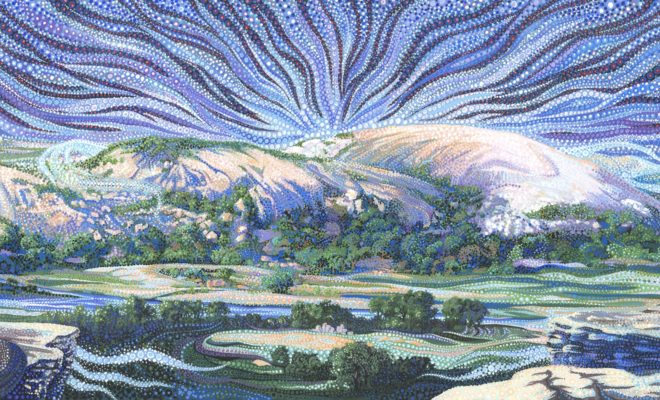In the heart of the Texas Hill Country, equidistant between Fredericksburg and Llano, is a place of legends, a place where stories trickle down like rainwater through granite gravel, a place where coyotes howl and stars tell stories in the sky. These days, it is called Enchanted Rock State Natural Area, but it is often called E-Rock, and known by locals simply as “The Rock.”
Fredericksburg claims the title of “Gateway to Enchanted Rock,” but Austinites find it closer to get there through Llano. The drive into Llano from any direction is visually satisfying, doubly so in spring wildflower season. And then there’s the Llano River, and, as you may already know, remarkable BBQ. At the Rock, visitors will find two almost-lost pleasures: dark night skies and remarkable quiet. Enchanted Rock holds Gold status as an International Dark Sky Park, and the ability to see stars, planets, and meteorites is a big part of what makes this one of our favorite parks. The domes are closed after dark, but ranger-led night hikes are very popular. For these and many other reasons, a visit to Enchanted Rock is a sort of pilgrimage for Texans.
Enchanted Rock was officially discovered by Anglo-Texans in 1829 by Captain Henry S. Brown, who led a party of 39 men from DeWitt’s Colony (now Gonzales) and marched to the head of the San Saba River. The purpose of the trip was to subdue the hostile Waco and Tehuacana Indians, and one of their two encounters was near Enchanted Rock. The 400-foot-tall granite dome had likely been seen by Spanish explorer Alvar Nunez Cabeza de Vaca way back in 1535. Enchanted Rock lay along a branch of the well-traveled Pinta Trail, which also passed through Fort Martin Scott in Fredericksburg. All these people were latecomers, however, as archeological surveys show evidence of extensive habitation by people we now call “First Texans,” between 10,000 and 12,000 years ago.
Photo provided by Juan Santillan
It would be no surprise to today’s visitor that some of these First Texans lived along Sandy Creek and Walnut Springs Creek at the Rock. They cooked sotol bulbs and other foods by building a fire on top of flat rocks, placing the food on the rocks, then covering with dirt. Food was boiled by placing fire-heated rocks into water-filled baskets, skins, gourds, or pots. Hunting weapons were primarily stone-tipped darts thrown by a spear thrower, or atlatl, which could propel the dart to a hide-piercing 93 mph. Bows didn’t come into use in the area until use until 1,300 years ago; the arrows had very small points many call bird points. The design of the park intentionally avoided areas where cultural artifacts abounded, but the park had already been picked over by arrowhead hunters years before. It is unlikely the casual visitor will ever find a point. Don’t go looking for artifacts—you aren’t going to find any—but if you do, leave it where it is and notify park staff. Taking it home is a significant violation of state law.
What you will see, except in the dead of winter, are vultures soaring above the domes. Both black vultures and turkey vultures spend much time in the area, and in the evening I have seen kettles with as many as 60 vultures soaring in circles in the updrafts on the southeast side of the domes. You may also encounter deer in surprising places, and at night foxes and ring-tailed cats. At night campers will be thrilled by the howling of coyotes and the hooting of owls. Sandy Creek holds non-venomous, plain-bellied water snakes. Herds of feral hogs sometimes pass through the park leaving damage behind, but it is unlikely you would see them. Summer temperatures on the surface of the domes regularly reach 134 degrees or more, which is one of the reasons pets are no longer allowed up there. When it was opened as a private park by the Moss family in 1927, a new Pontiac was driven to the top of Enchanted Rock Dome as a publicity stunt. No cars drive up now, but from time to time the top is visited by a rescue helicopter.




